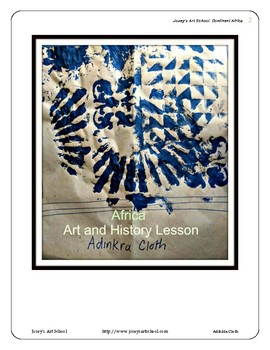Africa Adinkra Cloth Art Lesson Montessori Grade Pre-K to 5th Common Core
- PDF
Description
Are you an elementary school teacher looking to broaden your students' artistic horizons while exploring rich cultural traditions? Look no further! We're thrilled to present "Adinkra Art: Exploring African Heritage," an inspiring art lesson designed to spark curiosity, celebrate diversity, and provide a meaningful learning experience for both you and your students.
Why Choose "Adinkra Art: Exploring African Heritage"?
- Cultural Significance: Adinkra Art: Discover the beauty and cultural significance of Adinkra art, a traditional craft originating from West Africa. With its rich symbolism and visual storytelling, this art lesson provides a unique opportunity for students to explore the history, traditions, and values embedded within Adinkra symbols.
- Engaging Activities: Your young artists will embark on an immersive journey, exploring the history and meaning of Adinkra symbols. Through hands-on activities, they'll create their own Adinkra-inspired artwork, applying the techniques and symbolism to visually communicate powerful messages. This lesson encourages cultural appreciation and artistic expression.
- Educational and Historical Context: "Adinkra Art: Exploring African Heritage" goes beyond art creation by delving into the historical and cultural context of Adinkra symbols. Students will learn about the Ashanti people of Ghana, their traditions, and the significance of Adinkra symbols as a means of communication, fostering cross-cultural understanding.
- Easy-to-Follow Lesson Plan: Simplify your planning process with our meticulously crafted lesson plan. It includes comprehensive instructions, a materials list, and helpful tips, ensuring a seamless and enjoyable teaching experience. Whether you're an experienced art educator or new to teaching art, you'll find this lesson plan user-friendly and accessible.
- Promotes Cultural Appreciation: By exploring Adinkra art, students will gain an appreciation for the diversity and beauty of different cultures. They'll develop a broader perspective, fostering empathy and respect for traditions and values different from their own.
- Enhances Visual Communication Skills: Adinkra art provides a unique opportunity for students to explore visual communication. By creating their own Adinkra-inspired artwork, they'll develop their ability to convey meaning and tell stories through symbols, colors, and composition.
CLICK HERE to view my freebies
CLICK HERE to view my DRAWING LESSONS
CLICK HERE to view my ART WITH THE MASTERS ART LESSONS
CLICK HERE to view my CONTEMPORARY ART LESSONS
CLICK HERE to view my ART LESSONS THAT COMPLIMENT POPULAR BOOKS
CLICK HERE to view my SELF ESTEEM PROJECTS
CLICK HERE to view my CLASS MURAL IDEAS
CLICK HERE to view my FUN ART FOLK ART LESSONS
CLICK HERE to view my 3 BUNDLED LESSONS
CLICK HERE to view my 5 BUNDLED LESSONS
Make sure to click the GREEN STAR near my store name so that you can stay in touch with my store. I create new lessons every week.





